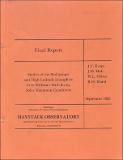Studies of the Midlatitude and High Latitude Ionosphere from Millstone Hill during Solar Maximum Conditions
Author(s)
Evans, J. V.; Holt, J. M.; Oliver, W. L.; Wand, R. H.
Downloadsept82.pdf (257.5Mb)
Metadata
Show full item recordAbstract
This report summarizes the work carried out at the Millstone Hill radar from April 1979 through March 1982 in studies of the earth's upper atmosphere and ionosphere with the support furnished by the National Science Foundation (Grant ATM-79-09189). Most notable were new studies of the auroral and subauroral regions of the ionosphere using a scanning technique in which the 1° beam of the UHF steerable radar is scanned at a fixed elevation (typically 4°) through 180° or 360° azimuth. This technique provides maps of the electron density, electron and ion temperatures and line-of-sight drifts at fixed altitudes as functions of invariant latitude and local time. These show a rich variety of behavior depending upon magnetic activity and season. In particular, the nighttime trough frequently is found to appear first in mid-afternoon at latitudes where the ion drift is high and sunward. Later the trough usually is found equatorwards of regions of fast convection. It is suggested that troughs may be manufactured in regions of rapid flow during substorms and then corotate with the earth as 'fossils' once the electric fields have diminished. Other studies reported herein include the analysis of the daily mean temperature, and the semidurnal temperatures and winds in the lower thermosphere as well as studies of the exospheric temperature. The report includes a detailed account of the improvements made in both the hardware and the software at the radar during the three-year period.
Date issued
1982-09Publisher
Haystack Observatory
Series/Report no.
Millstone Technical Reports;